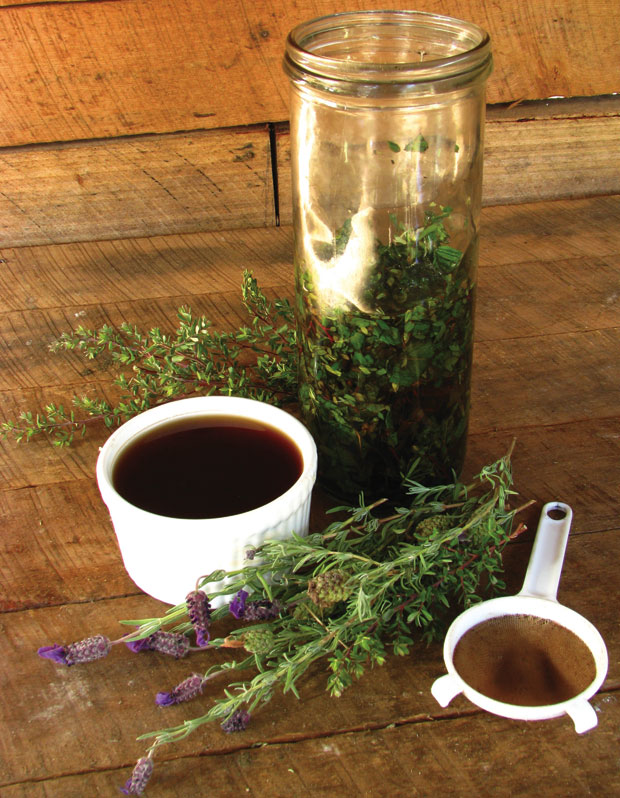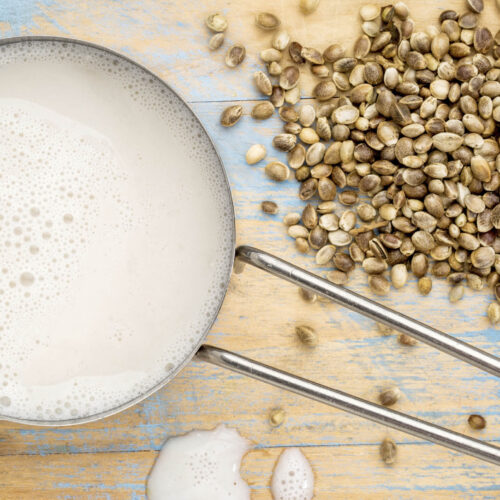Natural pest repellents you can make from your garden
2010-06-01T00:19:53+10:00
Whether it’s mozzies, flies or cockroaches, humans are constantly plagued by insect pests. Here's some simple plant-based repellents.
I have a game I like to play. It’s a variation of ‘three wishes from a genie’ and it goes like this: An anonymous benefactor has granted the permanent eradication of three insect pests that bother me and other humans. I have to decide, out of all the insects that drive me insane, my top three. After deliberation, I usually settle on mosquitoes, flies and cockroaches – in that order.
Alas, despite the fun of the game, there is no magic wand to be waved. Instead, I have to use my own skills to eradicate or repel them, using either plants I can grow, or essential oils made from them. Luckily I’ve had plenty of experience and, while I’m no genie, I hope these tips help you win your own personal battle of the bugs.
These recommendations are based on my own experience and that of other gardeners; they are not guaranteed to work every time in every situation, but used with care they represent viable and safe alternatives to the sometimes highly toxic chemicals that are used in commercial preparations.
Mosquitoes
Eucalyptus oil
A New England Journal of Medicine study found that a 30 per cent solution of eucalyptus oil prevented mosquito bites for two hours; citronella oil was also effective, but over a shorter time period.
Lemongrass (Cymbopogon citrates)
This is another essential oil that protects against mosquito bites. Lemongrass can be easily grown in the warmer areas of Australia. The pulpy juice extracted from the stem base can be rubbed over the skin to thwart mozzies, while planting it close to the house will also have a repellent effect. Lemongrass is readily available in the herb section of nurseries in warmer regions. The plant grows in large clumps up to a metre tall. It is drought tolerant to the point that it absolutely hates getting its feet wet.
Other options
If it’s not possible to grow lemongrass in your area, then sage, rosemary, lavender and basil leaves rubbed on your skin will have a similar effect. If you object to smelling like a pizza, you can always throw the leaves of these herbs on the coals of a barbecue, creating a smoky aroma to reduce the local population. This works for sandflies, too. Alternatively, mix one part garlic juice with five parts water in a spray bottle to use on your skin. I’m not sure how this will go down in polite society, but it is said to be effective and lasts 5–6 hours.
Flies
I’m often reminded of the scene in the movie Falling Down, where the fly keeps landing on Michael Douglas’s face. I understand the rage that one persistent fly can cause, but I’m still not up for releasing a cocktail of chemicals from an aerosol can.
If the numbers build up inside the house I close the curtains, leaving one conspicuously open, along with the window; the flies fly towards the light and discover themselves outside. I picked up this idea from a cattle farmer whose cows were being harassed by cattle fly. He built a walk-through stall that was dark except for one clear strip panel on the roof. The cattle soon learned to walk through it, the cattle flies flew towards the light, and the cows emerged at the other end minus the fly. How non-toxic is that!
Not much help to us, of course. However, most people have a patch of peppermint in their garden. Try rubbing the leaves on your skin, crushing them to release the aromatic oils, to deter flies. Eucalyptus, basil, bay, sage and rosemary leaves have a similar effect. Or try a cloth sprinkled with clove or eucalyptus oil or a bouquet of wormwood hung over a doorway.
Cockroaches
I’ve put cockroaches at number three, despite having solved my own problem by relocating to Tasmania where the house-dwelling varieties are much less common. But for the citizens of the cockroach-occupied territories of the world, here are a few hints.
The cockroach life-cycle is a long one; they spend 6–7 weeks as an egg and 9–13 months as a nymph before reaching adult status, moulting eight times in the process. All up, they can live for 1–2 years.
One of the most effective deterrents is household cleanliness. Being scrupulous about cleaning benches, cupboards and floors, and keeping food in air-tight containers will all help. But this is only part of the answer; using an array of aromas they detest can also be useful.
Mix 50g of cloves with 50g of Epsom salts in a shallow dish and place where cockroaches normally congregate. Undiluted clove oil wiped on cupboard surfaces and other favourite haunts will also do the trick. Cockroaches also dislike tea tree and pennyroyal*. However, there are contraindications for using this herb during pregnancy, especially near food, so it’s best to avoid the risk. Laboratory tests have shown that cockroaches will avoid catnip, while the ends of cucumbers can also be used as a deterrent.
I’ve also used jars with the openings smeared with oil, so they can get in but can’t get back out. The next morning, I used to empty the night’s catch into the chook pen, thus conveniently converting cockroaches into eggs.
And the runners up are…
Head lice
These little critters hate lavender, tea tree and citronella. Comb conditioner through affected hair daily for 10 days, using a nit comb to remove the eggs and lice. This should disrupt their lifestyle sufficiently to make eradication easier. You can then make your own lice deterrent tincture (see below), which can be sprayed on the hair (avoiding the eyes) before children leave for school. Hopefully you will have the herbal ingredients in your garden. A tincture is a liquid extraction of the active ingredients in herbs, which is partially preserved by alcohol. It keeps for around two years in a cool, dark place.
Head lice tincture
To make the tincture, use a liquid base of 25 per cent alcohol to 75 per cent water (for example, 250ml of vodka, which doesn’t contain additives, to 750ml of water.) Set this mixture aside. Next, gather herbs such as tea tree, peppermint, lavender leaves and flowers, and lemongrass. Add these at a ratio of 1 part herbs to 4 parts alcohol (for example, add 250g of chopped herbs to a litre of alcohol mix).
Pour this mix into a jar or container with an airtight lid and place in a cool spot for a couple of weeks, shaking every couple of days. Using muslin or a fine strainer, strain the liquid into a second jar, squeezing as much liquid as possible from the herb mass. This liquid is your tincture. It smells good.
Ticks
Guinea fowl are supposedly good at reducing tick numbers. I tried these, but found them giddily stupid. You can make your own repellents to keep ticks off dogs and humans (see below), although dogs with their sensitive noses may not appreciate your efforts. Avoid direct skin contact and cease use if any irritation occurs.
Tick repellent (for dogs)
- 20 drops rose geranium oil; and 2ml alcohol, added to 300ml of water.
- Combine the two, shake well, pour into a spray bottle and lightly spray onto the dog.
I have a game I like to play. It’s a variation of ‘three wishes from a genie’ and it goes like this: An anonymous benefactor has granted the permanent eradication of three insect pests that bother me and other humans. I have to decide, out of all the insects that drive me insane, my top three. After deliberation, I usually settle on mosquitoes, flies and cockroaches – in that order.
Alas, despite the fun of the game, there is no magic wand to be waved. Instead, I have to use my own skills to eradicate or repel them, using either plants I can grow, or essential oils made from them. Luckily I’ve had plenty of experience and, while I’m no genie, I hope these tips help you win your own personal battle of the bugs.
These recommendations are based on my own experience and that of other gardeners; they are not guaranteed to work every time in every situation, but used with care they represent viable and safe alternatives to the sometimes highly toxic chemicals that are used in commercial preparations.
Mosquitoes
Eucalyptus oil
A New England Journal of Medicine study found that a 30 per cent solution of eucalyptus oil prevented mosquito bites for two hours; citronella oil was also effective, but over a shorter time period.
Lemongrass (Cymbopogon citrates)
This is another essential oil that protects against mosquito bites. Lemongrass can be easily grown in the warmer areas of Australia. The pulpy juice extracted from the stem base can be rubbed over the skin to thwart mozzies, while planting it close to the house will also have a repellent effect. Lemongrass is readily available in the herb section of nurseries in warmer regions. The plant grows in large clumps up to a metre tall. It is drought tolerant to the point that it absolutely hates getting its feet wet.
Other options
If it’s not possible to grow lemongrass in your area, then sage, rosemary, lavender and basil leaves rubbed on your skin will have a similar effect. If you object to smelling like a pizza, you can always throw the leaves of these herbs on the coals of a barbecue, creating a smoky aroma to reduce the local population. This works for sandflies, too. Alternatively, mix one part garlic juice with five parts water in a spray bottle to use on your skin. I’m not sure how this will go down in polite society, but it is said to be effective and lasts 5–6 hours.
Flies
I’m often reminded of the scene in the movie Falling Down, where the fly keeps landing on Michael Douglas’s face. I understand the rage that one persistent fly can cause, but I’m still not up for releasing a cocktail of chemicals from an aerosol can.
If the numbers build up inside the house I close the curtains, leaving one conspicuously open, along with the window; the flies fly towards the light and discover themselves outside. I picked up this idea from a cattle farmer whose cows were being harassed by cattle fly. He built a walk-through stall that was dark except for one clear strip panel on the roof. The cattle soon learned to walk through it, the cattle flies flew towards the light, and the cows emerged at the other end minus the fly. How non-toxic is that!
Not much help to us, of course. However, most people have a patch of peppermint in their garden. Try rubbing the leaves on your skin, crushing them to release the aromatic oils, to deter flies. Eucalyptus, basil, bay, sage and rosemary leaves have a similar effect. Or try a cloth sprinkled with clove or eucalyptus oil or a bouquet of wormwood hung over a doorway.
Cockroaches
I’ve put cockroaches at number three, despite having solved my own problem by relocating to Tasmania where the house-dwelling varieties are much less common. But for the citizens of the cockroach-occupied territories of the world, here are a few hints.
The cockroach life-cycle is a long one; they spend 6–7 weeks as an egg and 9–13 months as a nymph before reaching adult status, moulting eight times in the process. All up, they can live for 1–2 years.
One of the most effective deterrents is household cleanliness. Being scrupulous about cleaning benches, cupboards and floors, and keeping food in air-tight containers will all help. But this is only part of the answer; using an array of aromas they detest can also be useful.
Mix 50g of cloves with 50g of Epsom salts in a shallow dish and place where cockroaches normally congregate. Undiluted clove oil wiped on cupboard surfaces and other favourite haunts will also do the trick. Cockroaches also dislike tea tree and pennyroyal*. However, there are contraindications for using this herb during pregnancy, especially near food, so it’s best to avoid the risk. Laboratory tests have shown that cockroaches will avoid catnip, while the ends of cucumbers can also be used as a deterrent.
I’ve also used jars with the openings smeared with oil, so they can get in but can’t get back out. The next morning, I used to empty the night’s catch into the chook pen, thus conveniently converting cockroaches into eggs.
And the runners up are…
Head lice
These little critters hate lavender, tea tree and citronella. Comb conditioner through affected hair daily for 10 days, using a nit comb to remove the eggs and lice. This should disrupt their lifestyle sufficiently to make eradication easier. You can then make your own lice deterrent tincture (see below), which can be sprayed on the hair (avoiding the eyes) before children leave for school. Hopefully you will have the herbal ingredients in your garden. A tincture is a liquid extraction of the active ingredients in herbs, which is partially preserved by alcohol. It keeps for around two years in a cool, dark place.
Head lice tincture
To make the tincture, use a liquid base of 25 per cent alcohol to 75 per cent water (for example, 250ml of vodka, which doesn’t contain additives, to 750ml of water.) Set this mixture aside. Next, gather herbs such as tea tree, peppermint, lavender leaves and flowers, and lemongrass. Add these at a ratio of 1 part herbs to 4 parts alcohol (for example, add 250g of chopped herbs to a litre of alcohol mix).
Pour this mix into a jar or container with an airtight lid and place in a cool spot for a couple of weeks, shaking every couple of days. Using muslin or a fine strainer, strain the liquid into a second jar, squeezing as much liquid as possible from the herb mass. This liquid is your tincture. It smells good.
Ticks
Guinea fowl are supposedly good at reducing tick numbers. I tried these, but found them giddily stupid. You can make your own repellents to keep ticks off dogs and humans (see below), although dogs with their sensitive noses may not appreciate your efforts. Avoid direct skin contact and cease use if any irritation occurs.
Tick repellent (for dogs)
- 20 drops rose geranium oil; and 2ml alcohol, added to 300ml of water.
- Combine the two, shake well, pour into a spray bottle and lightly spray onto the dog.
Tick repellent (for humans)
- 10–25 drops rose geranium oil; and 2 tbsp almond oil.
- Combine the two in a dark glass jar, cap tightly, then shake the mixture before using it to dab on clothes or skin.
Other essential oils found to repel ticks include oil of cloves, peppermint, lavender, lemon, lemongrass, sage and thyme. A few drops on an absorbent dog collar can help reduce or eliminate ticks. Pennyroyal (which is also known as tickweed) is effective too.
Fleas
Every flea on a dog’s back represents approximately another 30 in the house. I’ve walked into a supposedly vacant house and the carpet has risen and attached itself to my legs.
A flea can live for 90 days and, in that time, produce 5000 more fleas – a circus act and a half. The eggs can survive for up to a year, making them an enormous challenge to eliminate. Herbal flea collars are available for dogs, or you can concoct your own by rubbing peppermint, lavender, lemongrass, tea tree, spearmint or lavender oils on a dog collar. Scattering sprigs of these plants on your pet’s bedding will reduce its attractiveness as a breeding zone. Wormwood, rue and tansy leaves can also be effective deterrents. As poet and farmer Thomas Tusser (1524-1580) said: “Where chamber is sweeped, and wormwood is strowne, No flea for his life dare abide to be knowne.”
Ants
If you are walking in areas where biting ants abound, rubbing the leaves of peppermint and basil on your skin and clothes will make the ants less inclined to attack. If they do, crushed young bracken fern exudes a juice that will help calm the pain. In the kitchen, peppermint oil drizzled across the line of advance will cause great confusion and, hopefully, a retreat.
Bees and wasps
Bees and wasps dislike the smell and taste of feverfew. In fact, beekeepers of old used to tie bouquets of it around their necks to repel them. A member of the chrysanthemum family, feverfew is a drought tolerant flower not unlike chamomile to look at, and self-seeds aggressively. It reduces the pollination of plants around it due to its repellent effect. If stung, the crushed leaves and flowers make a soothing paste.
Moths and weevils
It seems many things repel moths; homemade sachets can be made with almost any aromatic herb including citronella, sage, lavender, cedar chips, peppercorns, rosemary, rose petals, vetiver, dried lemon peel, cloves, thyme, mint, cinnamon sticks, eucalyptus and, of course, camphor (a great excuse to chop down a feral camphor laurel and park bits of it in moth-prone areas.)
To make sachets, use finely chopped dried herb leaves and flowers, diced peel, or whole cloves and cinnamon sticks. Tie or sew into a handkerchief (or use muslin bags) and hang or place in moth-afflicted areas. I’ve had no problems with weevils since I started placing a bay leaf in the tops of jars and containers storing weevil-friendly dry goods like flour and rice.
Sources
Books
Australian Herbal: A Practical Guide To Growing And Using Herbs In Temperate Australia And New Zealand, Penny Woodward, Hyland House.
Home Herbal, Penelope Ody, Good Books.
Encyclopedia of Medicinal Plants, Andrew Chevallier, Dorling Kindersley.
The Fragrant Pharmacy, Valerie Ann Worwood, Macmillan.
For more practical solutions that will help you live a greener life, subscribe to the magazine. Head here to find out how easy it is!






